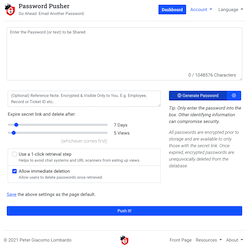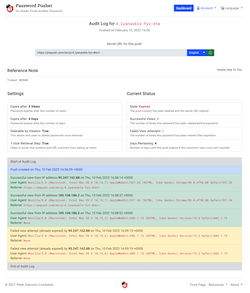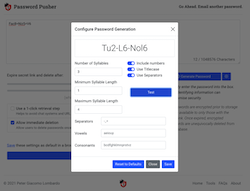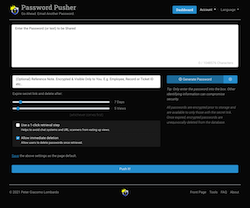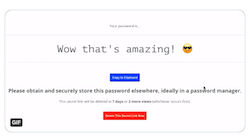Give your users the tools to be secure by default.
Password Pusher is an open source application to communicate passwords over the web. Links to passwords expire after a certain number of views and/or time has passed.
Hosted at pwpush.com but you can also easily run your own private instance with just a few steps.
- Easy-to-install: Host your own via Docker, a cloud service or just use pwpush.com
- Open Source: No blackbox code. Only trusted, tested and reviewed open source code.
- Versatile: Push passwords, text, files or URLs that auto-expire and self delete.
- Audit logging: Track and control what you've shared and see who has viewed it.
- Encrypted storage: All sensitive data is stored encrypted and deleted entirely once expired.
- Host your own: Database backed or ephemeral, easily run your own instance isolated from the world.
- JSON API: Raw JSON API available for 3rd party tools or command line via
curlorwget. - Command line interface: Automate your password distribution with CLI tools or custom scripts.
- Logins: Invite your colleagues and track what is pushed and who retrieved it.
- Admin Dashboard: Manage your self-hosted instance with a built in admin dashboard.
- Internationalized: 29 language translations are bundled in. Easily selectable via UI or URL
- Themes: 26 themes bundled in courtesy of Bootswatch. Select with a simple environment variable.
- Unbranded delivery page: No logos, superfluous text or unrelated links to confuse end users.
- Customizable: Change text and default options via environment variables.
- Light & dark themes: Via CSS @media integration, the default site theme follows your local preferences.
- Re-Brandable: Customize the site name, tagline and logo to fit your environment.
- Custom CSS: Bundle in your own custom CSS to add your own design.
- >10 Years Old: Password Pusher has securely delivered millions and millions of passwords in its 10 year history.
- Actively Maintained: I happily work for the good karma of the great IT/Security community.
- Honest Software: Open source written and maintained by me with the help of some great contributors. No organizations, corporations or evil agendas.
💌 --> Sign up for the newsletter to get updates on big releases, security issues, new features, integrations, tips and more.
Password Pusher is also on Twitter, Gettr and on Facebook
→ Go to pwpush.com and try it out.
or
→ Run your own instance with docker run -d -p "5100:5100" pglombardo/pwpush:latest or a production ready setup with a database & SSL/TLS.
or
→ Use one of the 3rd party tools that interface with Password Pusher.
See the full Password Pusher documentation here.
Thanks to our great translators!
If you would like to volunteer and assist in translating, see this page.
| Name | Language | |
|---|---|---|
| Oyale | Catalan | |
| Finn Skaaning | Danish | |
| Mihail Tchetchelnitski | Finnish | |
| Thibaut | French | |
| Thomas Wölk | German | Github, Twitter |
| Martin Otto | German | |
| Robin Jørgensen | Norwegian | |
| Łukasz | Polish | |
| Jair Henrique | Portuguese | |
| Fabrício Rodrigues | Portuguese | |
| Ivan Freitas | Portuguese | |
| Sara Faria | Portuguese | |
| Oyale | Spanish | |
| johan323 | Swedish | |
| Fredrik Arvas | Swedish | |
| Pedro Marques | European Portuguese |
Also thanks to translation.io for their great service in managing translations. It's also generously free for open source projects.
Thanks to:
-
@fiskhest the Kubernetes installation instructions and manifests.
-
@sfarosu for contributing the Docker, Kubernetes & OpenShift container support.
-
sirux88 for cleaning up the Docker files and adding multistage builds.
Thanks to:
-
@iandunn for better password form security.
-
Kasper 'kapöw' Grubbe for the JSON POST fix.
-
JarvisAndPi for the favicon design
...and many more. See the Contributors page for more details.
This project is licensed under the terms of the Apache License 2.0 license. See LICENSE for more details.
@misc{PasswordPusher,
author = {Peter Giacomo Lombardo},
title = {An application to securely communicate passwords over the web. Passwords automatically expire after a certain number of views and/or time has passed.},
year = {2024},
publisher = {GitHub},
journal = {GitHub repository},
howpublished = {\url{https://github.com/pglombardo/PasswordPusher}}
}




